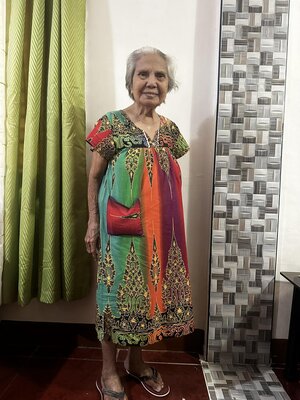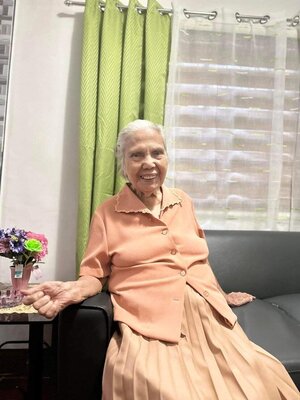- TOP
- 資料館
- FOCUS
- March 2024 - Volume Volume 115
- "Returning Home" - Story of Nanay Magdalena
FOCUS March 2024 Volume Volume 115
"Returning Home" - Story of Nanay Magdalena
My name is Magdalena Akagishi and my father is Toraichi Akagishi, a Japanese. My father first came to Manila and then to Santa Barbara town in Iloilo province. My father was a handyman and also a businessperson. In Iloilo, my father supervised a group of carpenters in constructing a prison building. He worked with a few other Japanese including Jose Hatakeyama, who was married to a Filipina, "Kodaira" and "Miyahira."
 My mother, Olympia, met my father in Santa Barbara. My mother's father was a goldsmith and palm wine producer, and my mother sold palm wine and food. My father married my mother when she was fifteen years old on 16 August 1910 at the Catholic Church in Lucena town. My father adopted Mariano as his first name, likely a name he was given when he was baptized as a Catholic before marrying my mother.
My mother, Olympia, met my father in Santa Barbara. My mother's father was a goldsmith and palm wine producer, and my mother sold palm wine and food. My father married my mother when she was fifteen years old on 16 August 1910 at the Catholic Church in Lucena town. My father adopted Mariano as his first name, likely a name he was given when he was baptized as a Catholic before marrying my mother.
I have six siblings: Concepcion, Vicente, Lutgarda, Salvacion, Dolores, and Jose.
My father spoke Ilonggo, and so we spoke it at home. But I learned from him how to say things in Japanese, "mizu kudasai," "konnichiwa," "genki desuka," "sayonara," and so on.
In 1939, my mother passed away due to illness. I was eight years old then. After she passed away, my father took care of us. My father would eat raw fish, sukiyaki on a stove on the table, miso (soybean paste) and tofu at home. He was a kind man who never scolded his children.
During the War
The war broke out when I was eleven years old, in Grade 5 of primary school. My father was sent to prison. But when the Japanese army landed in Iloilo, my father returned home. He left again that same day to serve in the Japanese army, taking with him my youngest brother, Jose. A few weeks later, my brother Vicente followed my father in the Japanese army, and my sister Lutgarda, who spoke Japanese and Ilonggo, was assigned to work as an interpreter of the Japanese army. I did not know where my oldest sister, Concepcion, went. She who was already married at that time.
I and my sisters Salvacion and Dolores stayed home with our sick grandmother (my mother died before the war). My father came home one day wearing a military uniform with the rank of Lieutenant. My brother Vicente visited us every week and brought us food. However, the Filipino guerrillas who opposed the Japanese military became more active, and we lost contact with my brother. Our house was burned down later.
I and my two sisters (Salvacion and Dolores) were detained by the Filipino guerillas and made to work in a plantation in the mountains of the neighboring province of Capiz.
Life after the War
When the war ended, I returned to our hometown not knowing what happened to my father and other siblings. My sister Lutgarda told us that the Japanese garrison was bombed and my father was unable to walk because of dysentery and died when the garrison was bombed.
My three siblings (Concepcion, Vicente and Lutgarda) were considered Japanese and subsequently "repatriated" to Japan. Lutgarda got married to another second generation Japanese (nikkeijin), Demetrio Kunimutsu, who she met on the ship that brought them to Japan. I was sent to live with my mother's cousin and returned to primary school in New Lucena in Iloilo City. After graduating from primary school, I was sent to study in a secondary school in Manila, where I lived with a relative in San Miguel district and worked as a domestic help. Contrary to what I heard, I was not allowed to go to school. I went to a vocational school to learn secretarial work and typing, but only for a month. I was not treated well.
Many years later, I bore four children.
In 1959, I went to the Japanese Embassy in Manila to consult about my father and siblings who were sent to Japan.
Sometime later I received a letter from the embassy with the address of my sister Lutgarda in Japan.
I corresponded with my sister Lutgarda. In 1976, my brother Vicente and my sister Lutgarda came home for a visit.
One of my sisters living in the Philippines was able to visit Japan in 1991 and met my nephews there. She also visited the grave of my sister Concepcion.
I was able to visit Japan for the first time in 2006 with my daughter, who decided to reside in the country.
I met my sister Lutgarda in Yokohama. But sadly I lost communication with my brother and sister in Japan after that meeting.
I wanted to go back to Japan. But when I applied in 2011 to renew my Philippine passport, the Department of Foreign Affairs in Manila refused to issue a new Philippine passport. I was told that I could not have a Philippine passport because my father was a Japanese.
Since the Philippine government considered me a Japanese, why can the Japanese government not listen to my plea to recognize me as a Japanese descendant and give me a chance to visit my father's birthplace, Yamaguchi-ken, and also meet again my brother and sister in Japan before my eyes closed? I just had no idea what to do.
In 2022, an opportunity suddenly came. One of my nieces living in Japan, Josephine Alcaide, contacted a Japanese non-profit organization that was helping war-displaced Japanese descendants recover their Japanese nationality and sought help for my case. This was the Philippine Nikkeijin Legal Support Center (PNLSC) based in Tokyo.
I was also able to know the Cebu Nikkei-jin Kai Inc, (CNJK), the nearest nikkei-jin association I could contact in the Philippines, which also helped me in gathering documents.
PNLSC and CNJK worked for almost a year preparing a court petition to add my name in the family registry of my father. The petition was filed in the Yamaguchi family court in May 2023. The court approved the petition in July 2023, three months later!
Final Words
The legacy of my late father, Toraichi Akagashi, paved the way for my family to have an equal opportunity to live and work in Japan.
Being the only surviving child of Toraichi Akagishi in the Philippines, I have always felt a deep connection to Japan and its rich culture. The approval of my petition did not only bring immense joy but also a sense of fulfillment knowing that I will soon be able to celebrate my forthcoming birthday in the land of the Rising Sun. It is indeed a dream come true for me and my family.
I eagerly anticipate this momentous occasion.
For more information, please contact: Philippine Nikkeijin Legal Support Center (PNLSC), Rm. 602, Sobi Building, 7banchi, 1-chome, Yotsuya, Shinjuku-ku, Tokyo, Japan, 160-0004; ph (813) 6709-8151; fax (813) 6709-8152; https://pnlsc.com/; e-mail: info@pnlsc.com.
______________________________________
Editor's note:
This is a short note on the possible reason why the Philippine Department of Foreign Affairs refused to renew her Philippine passport in 2011. It is likely due to the provisions of the 1987 Constitution on citizenship that relate to the provisions of the 1935 Constitution of the Philippines on Filipino citizenship as stated below:
ARTICLE IV.--CITIZENSHIP
SECTION 1. The following are citizens of the Philippines:
(3) Those whose fathers are citizens of the Philippines.
(4) Those whose mothers are citizens of the Philippines and, upon reaching the age of majority, elect Philippine citizenship. (Article IV on Citizenship)
The 1987 Constitution states that people "born before January 17, 1973, of Filipino mothers, who elect Philippine citizenship upon reaching the age of majority" are Filipino citizens. This reflects the provisions of the 1935 Constitution on Filipino citizenship.
Based on these 1935 Constitution provisions, the Philippine citizenship of a child of non-Filipino father and Filipino mother is acquired if such a child "elected" Philippine citizenship - an action to be done upon reaching the age of majority.
In the case of Magdalena, upon noticing that her father was a Japanese citizen and probably without a proof that she "elected" to become a Filipino citizen when she reached the age of majority, the Philippine Department of Foreign Affairs considered her a non-Filipino, or a Japanese citizen.
However, since she had not yet been recognized as a Japanese citizen by the Japanese government when she applied for renewal of Philippine passport in 2011, she was de facto stateless.
The Yamaguchi family court decision in July 2023 approving her petition to be registered in the family registry of her father provided her with the legal basis to be recognized as a Japanese national.
(See The 1935 Constitution, www.officialgazette.gov.ph/constitutions/the-1935-constitution/?__cf_chl_rt_tk=bWk52jKNfHr3mNedbDaZ9QPs5.4J1J5HAt6lPfruRGM-1711938418-0.0.1.1-1685.
ARTICLE IV, CITIZENSHIP, Section 1,THE 1987 CONSTITUTION OF THE REPUBLIC OF THE PHILIPPINES, https://www.officialgazette.gov.ph/constitutions/the-1987-constitution-of-the-republic-of-the-philippines/the-1987-constitution-of-the-republic-of-the-philippines-article-iv/.)

